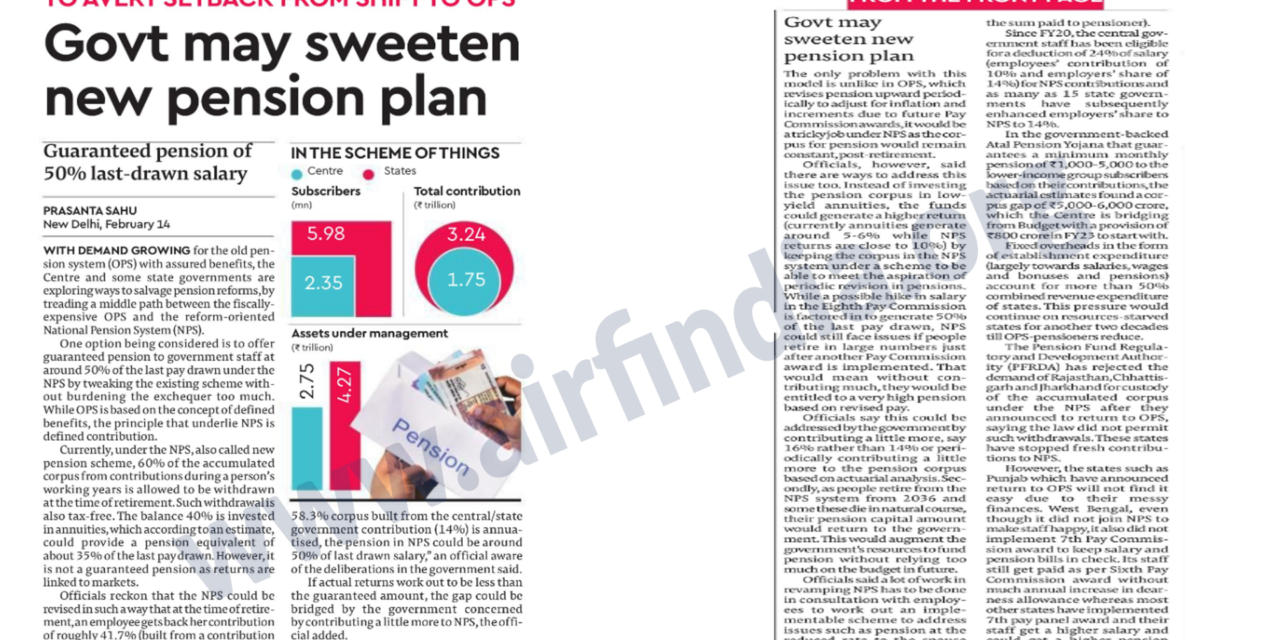With demand growing for the old pension system (OPS) with assured benefits, the Centre and some state governments are exploring ways to salvage pension reforms, by treading a middle path between the fiscally-expensive OPS and the reform-oriented National Pension System (NPS).
One option being considered is to offer guaranteed pension to government staff at around 50% of the last pay drawn under the NPS by tweaking the existing scheme without burdening the exchequer too much. While OPS is based on the concept of defined benefits, the principle that underlie NPS is defined contribution.
Currently, under the NPS, also called new pension scheme, 60% of the accumulated corpus from contributions during a person’s working years is allowed to be withdrawn at the time of retirement. Such withdrawal is also tax-free. The balance 40% is invested in annuities, which according to an estimate, could provide a pension equivalent of about 35% of the last pay drawn. However, it is not a guaranteed pension as returns are linked to markets.
Officials reckon that the NPS could be revised in such a way that at the time of retirement, an employee gets back her contribution of roughly 41.7% (built from a contribution of 10% of pay) as a lump sum amount.
“An analysis showed that if the balance 58.3% corpus built from the central/state government contribution (14%) is annuatised, the pension in NPS could be around 50% of last drawn salary,” an official aware of the deliberations in the government said. If actual returns work out to be less than the guaranteed amount, the gap could be bridged by the government concerned by contributing a little more to NPS, the official added.
The only problem with this model is unlike in OPS, which revises pension upward periodically to adjust for inflation and increments due to future Pay Commission awards, it would be a tricky job under NPS as the corpus for pension would remain constant, post-retirement.
Officials, however, said there are ways to address this issue too. Instead of investing the pension corpus in low-yield annuities, the funds could generate a higher return (currently annuities generate around 5-6% while NPS returns are close to 10%) by keeping the corpus in the NPS system under a scheme to be able to meet the aspiration of periodic revision in pensions.
While a possible hike in salary in the Eighth Pay Commission is factored in to generate 50% of the last pay drawn, NPS could still face issues if people retire in large numbers just after another Pay Commission award is implemented. That would mean without contributing much, they would be entitled to a very high pension based on revised pay.
Officials say this could be addressed by the government by contributing a little more, say 16% rather than 14% or periodically contributing a little more to the pension corpus based on actuarial analysis. Secondly, as people retire from the NPS system from 2036 and some these die in natural course, their pension capital amount would return to the government. This would augment the government’s resources to fund pension without relying too much on the budget in future.
Officials said a lot of work in revamping NPS has to be done in consultation with employees to work out an implementable scheme to address issues such as pension at the reduced rate to the spouse after the death of pensioners like in OPS (spouse gets half of the sum paid to pensioner).
Since FY20, the central government staff has been eligible for a deduction of 24% of salary (employees’ contribution of 10% and employers’ share of 14%) for NPS contributions and as many as 15 state governments have subsequently enhanced employers’ share to NPS to 14%.
In the government-backed Atal Pension Yojana that guarantees a minimum monthly pension of `1,000-5,000 to the lower-income group subscribers based on their contributions, the actuarial estimates found a corpus gap of `5,000-6,000 crore, which the Centre is bridging from Budget with a provision of `800 crore in FY23 to start with.
Fixed overheads in the form of establishment expenditure (largely towards salaries, wages and bonuses and pensions) account for more than 50% combined revenue expenditure of states. This pressure would continue on resources-starved states for another two decades till OPS-pensioners reduce.
The Pension Fund Regulatory and Development Authority (PFRDA) has rejected the demand of Rajasthan, Chhattisgarh and Jharkhand for custody of the accumulated corpus under the NPS after they announced to return to OPS in 2022, saying the law did not permit such withdrawals. These states have stopped fresh contributions to NPS.
However, even the states such as Punjab which have announced return to OPS will not find it easy due to their messy finances. West Bengal, even though it did not join NPS to make staff happy, it also did not implement 7th Pay Commission award to keep salary and pension bills in check. Its staff still get paid as per Sixth Pay Commission award without much annual increase in dearness allowance whereas most other states have implemented 7th pay panel award and their staff get a higher salary and could get a higher pension under NPS as well than West Bengal, analysts said.
While ruling out reversing the pension reforms and going back to the fiscally-disastrous unfunded OPS, which entails 50% of the last pay drawn as pension from the budget to the pre-2004 staff, the political executive is conscious of the increasing resonance of demand for OPS amid a spate of state/general elections in 2023-2024.
SOURCE:- FINANCIAL EXPRESS



